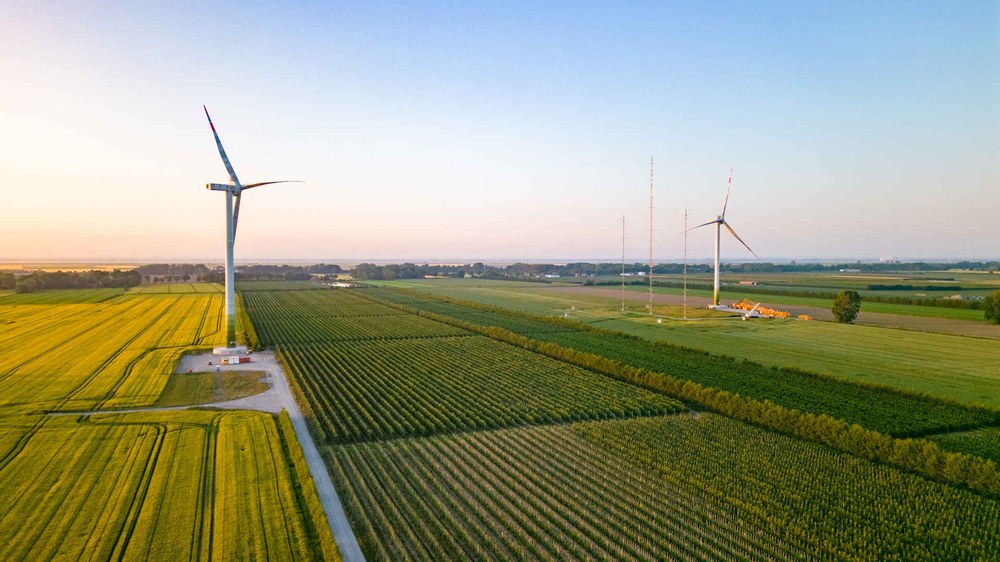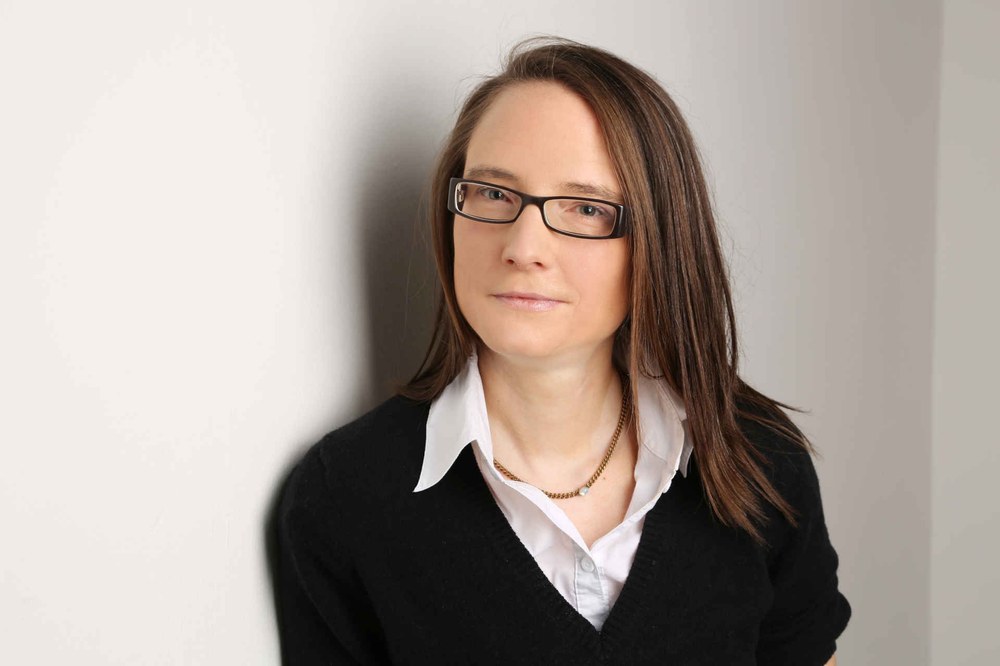Tomorrow's wind energy research – "We need to better understand the entire system"

- Significant improvements in the wind energy sector can be achieved through research into efficiency, cost-effectiveness and noise production.
- In this interview, DLR expert Michaela Herr gives an insight into the aspects that wind energy research will increasingly focus on in the future.
- The new technologies emerging from this research will also make important contributions to further increasing the societal acceptance of wind energy.
- Focus: Energy, wind energy, technology transfer
A quarter of the electricity used in Germany in 2022 was generated using wind energy. That makes wind the second largest source of energy for the country after coal. By the end of 2030, the total onshore wind turbine capacity in Germany will reach approximately 115 gigawatts. Currently, the capacity is just under 60 gigawatts. All German federal states are legally obliged to designate two percent of their land for purposes related to wind energy by 2032. In addition to the construction of new turbines, there will be a focus on 'repowering' – replacing old wind turbines with more powerful ones. These goals would be difficult to achieve without intensive research and close cooperation between science and industry. In this interview, Michaela Herr from the German Aerospace Center (Deutsches Zentrum für Luft- und Raumfahrt; DLR) gives an insight into the challenges and potential associated with tomorrow's wind energy research.
Michaela Herr has been leading the newly founded Wind Energy Department at the DLR Institute of Aerodynamics and Flow Technology in Braunschweig for one year. Herr, who studied Technical Biology, joined DLR 20 years ago for her PhD thesis on aeroacoustics. This subject area involves the study of noise generated by aerodynamic processes, that is, air flow around or through components. Knowing how this noise is generated and propagated can help prevent it. This in turn can make it possible to reduce the noise generated by aircraft, vehicles and even wind turbines. Wind energy research has always been one of Michaela Herr's favourite topics. She is convinced that many new technological advances remain to be discovered and applied in her field of research.
What are the biggest outstanding research topics in the field of wind energy?

Michaela Herr: There is still a lot of work to be done in wind energy research. We are only scratching the surface with many important questions. In terms of their fundamental design, large wind turbines will not look much different in the future. However, every aspect of them – from the individual components to the entire complex wind farm and its integration into the grid – will be smarter and intelligently controlled. There is still a lot of potential for improvement in the operation of wind farms. To make progress, we need to improve our expertise through the use of sensors and digital models to monitor wind farm operation, among other things. Meanwhile, research into new materials and production methods is enabling new wind turbines to be increasingly tall. At the same time, we want to arrange wind turbines ever more densely in order to make better use of existing areas and develop new ones in an optimal manner. To do this, we need to understand how the turbines influence each other and how they interact with the very changeable conditions on-site.
How can research help to further increase the societal acceptance of wind energy?
Herr: According to a Forsa survey, acceptance for expanding onshore wind energy is already high at approximately 80 percent. In light of the extensive expansion planned for the next few years, it is important that this remains the case. To achieve this, the people living in areas where new turbines are being built must be involved through early, scientifically sound and transparent communication.
The noise generated by wind turbines is often a critical issue. From my research, I know there are many ways to further reduce these noise emissions. Today's standard is the use of serrations – serrated trailing edges on the rotor blades. They reduce the sound emitted at the point of generation. There is also some leeway in turbine control to reduce noise pollution and improve efficiency during operation. How much noise is considered a nuisance depends on the volume, but also on the type of sound at the point of 'immission' – the location at which the sound is perceived. The fluctuating sound associated with the rotation of the rotor blades is more disturbing than a constant noise. In order to better predict the propagation of sound from the point of origin (emission) to the point of perception (immission), our modelling must include data on topography, weather and the various atmospheric layers present at the relevant turbines.
For this type of research to be successful, we need to improve our whole-system understanding of wind energy. At DLR, we have established an interdisciplinary approach to wind energy research. All aspects of our research are combined: aerodynamics, aeroacoustics, aeroelasticity, atmospheric physics, energy systems analysis, materials and manufacturing technology, sensor technology and software, and control and regulation technology. Our goal is to approach wind energy research in a data-driven and systemic way. That will allow us to draw better site-specific conclusions and develop individual solutions to make wind energy as efficient and quiet as possible within the unique context of each respective location.
What role will DLR's WiValdi wind energy research farm play in this?
Herr: WiValdi enables full-scale research under real environmental conditions – a unique opportunity for research and industry. The abbreviation WiValdi stands for Wind Validation. We want to use scientific methods to describe physical phenomena as precisely as possible and confirm model assumptions through experiment – that is, to validate them. To do this, we observe a broad range of wind flow processes over a an extended period: from large-scale atmospheric conditions to the smallest turbulence around the rotor blades. By combining this experimental data with our simulations, we improve our understanding and our ability to plan and build better wind farms in the future.
Individual musical instruments can sound beautiful, but their true potential is only revealed in concert with other instruments. The same applies to the individual research disciplines that work together at the WiValdi research farm to improve our understanding of wind energy as an overall system. From the foundations of the turbine to the tip of the blade, 150 metres up in the air, all components of the research wind farm are well equipped with sensors. These sensors measure temperature, humidity, wind speed, pressure and the smallest deformations on the rotor blades, and thus generate extensive data for later analysis. Even before the start of construction, DLR researchers carried out measurements at the site that will serve as comparative values going forward. In addition to the extensive instrumentation of the research farm and state-of-the-art measurement technology, its construction is also special. The two large wind turbines are arranged in a line following the prevailing wind, close behind one another. Commercial wind farms would not be arranged like this today because the second turbine is exactly in the wake of the first and must cope with very turbulent air. But this is exactly the scenario that interests us as researchers. This is the first time that we can investigate on a real scale what exactly happens when turbines are arranged in this way. This will help us better understand how to arrange wind farms more densely in the future and how to make better use of existing space while still achieving high efficiency.
How do research and industry work together in the field of wind energy?
Herr: At DLR, we work together with companies on many projects. In the field of wind energy, this includes all the major European manufacturers and many suppliers. Together, we design and test rotor technologies, for example. These include more efficient and quieter profiles for rotor blades or retrofitting measures to improve the control of air flow, noise and loads. We are also working on improving numerical and experimental procedures. A strong commercial mindset is important in this cooperation, and we are often surprised at how quickly the knowledge we generate flows into the companies' operational processes. Through the establishment of DLR's WiValdi wind energy research farm, we are working closely with Enercon, one of the leading manufacturers in the wind energy sector. They constructed two of the large wind turbines located at the research farm. A DLR team was involved in the production of the rotor blades for these turbines and integrated extensive research instrumentation directly into them. This kind of cooperation gives both parties a deep insight into the work of the other and requires mutual trust.
What are the challenges of collaboration between research and industry in the field of wind energy?
Herr: At the moment, the biggest challenges are the massive costs and competitive pressure on manufacturers, which leave little or no room for long-term research projects. Today, the electricity produced by wind power has to be one thing above all: cost-effective. Wind energy research at DLR supports both manufacturers and operators in this regard. Many research questions would be too financially risky for individual companies and would not be lucrative to research under current market conditions.
However, there are a number of advantages that have not yet been factored in. Sustainability, the development of leading technologies within Germany and Europe – and thus the strengthening of Germany as a prime location for research and industry – and the prospect of reliable power generation as close to the local area as possible are all significant factors. In this context, we must consider what is happening in the USA and China, where the wind energy sector is currently undergoing very dynamic developments.
How do you assess concepts such as airborne or vertical-axis wind turbines, which differ in shape and appearance from current turbines?
Herr: I can imagine these concepts could prove useful in the context of smaller wind farms and for specific markets. Airborne wind turbines need a lot of overhead space because they use steady, high-energy, high-altitude winds well above 200 metres. This might be difficult to achieve in densely populated areas and busy airspaces due to the associated approval process. These turbines are interesting for less developed, difficult-to-access areas where there is sufficient space. Their construction can be carried out cost-effectively and with little environmental impact.
Vertical-axis wind turbines may play a growing role in smaller, self-sufficient solutions for local energy supply. For example, they could be used at locations that are unsuitable for larger, classic wind turbines. As a complement to photovoltaics, they could, if well integrated, supply smaller buildings or businesses with additional electricity. Small wind turbines are simple and affordable to set up and operate, making them interesting for private individuals as well. The same applies to small- and large-scale wind turbines: their arrangement and site selection are decisive for efficiency.
